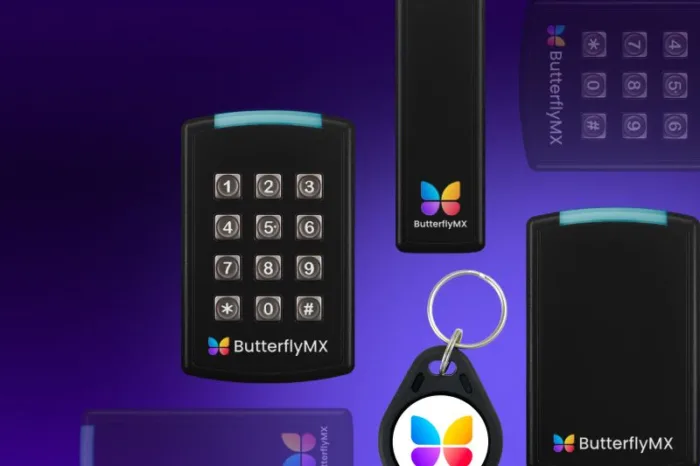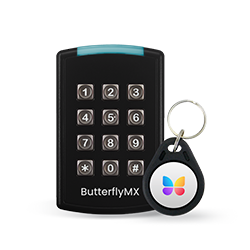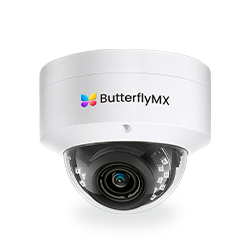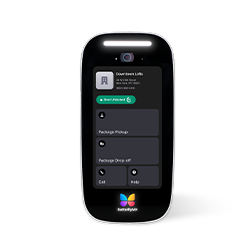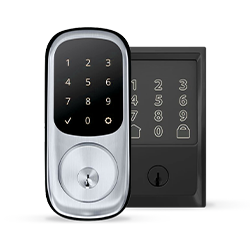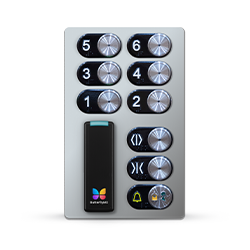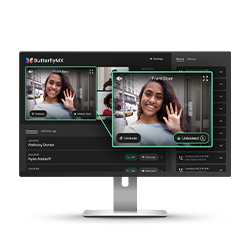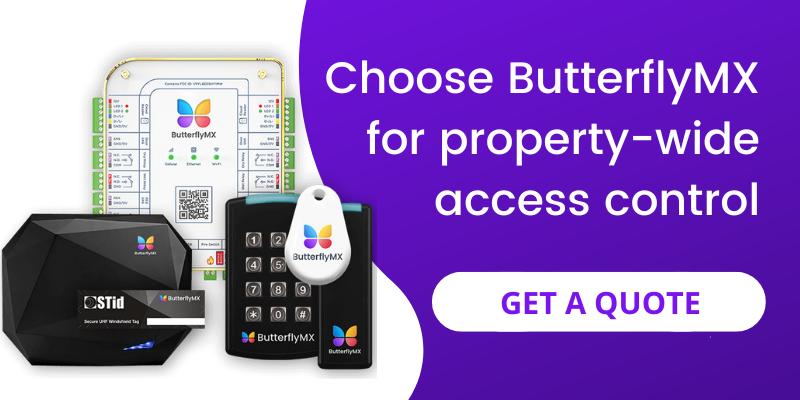Key takeaways:
- Key card and fob systems work by taking advantage of credentials, readers, controllers, and a door release.
- The most common types of key card systems include Wiegand, swipe, RFID, and proxy card systems.
- Some alternatives to key card or fob systems include biometrics, mobile access, and QR codes.
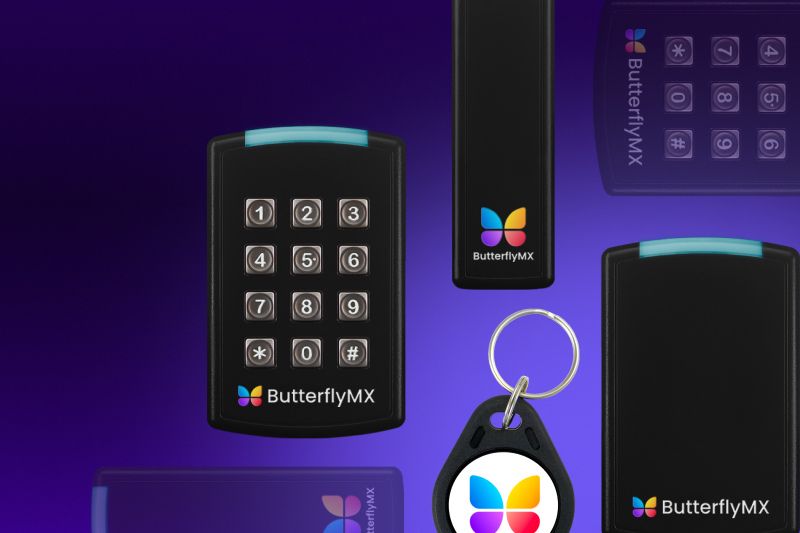
Key card and key fob systems are popular access control systems that you’ve likely used before, such as at a hotel. While these systems offer significant benefits, it’s difficult to determine if they are right for your property.
So, this guide reviews how key card and fob entry systems work and the most common types available. You’ll also discover the pros and cons of key cards or fobs, factors to consider when looking for a system, and potential alternatives. Most importantly, we cover a modern key card key fob system alternative.
This post covers:
More than 40K, 5-star reviews!
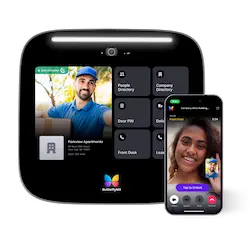
Video Intercoms
Open doors, gates & garages from anywhere.
Access Control
Fob, key cards, PINs, and mobile apps.
Security Cameras
Visibility throughout your property.
Vehicle Access
Hands-free access for gates & garages.
Package Room
Receive, store, and manage deliveries.
Smart Locks
Connect to all major brands and models.
Elevator Controls
Unlock key-fobbed elevators for anyone.
Front Desk Station
See all your doors and cameras in one place.
What are key card and key fob systems?
Key card and key fob systems are a type of electronic access control used to manage entry to certain areas. They store the necessary information to grant entry into a room or space.
This type of system is often chosen over traditional metal keys because of the higher level of security they offer. Property managers use key card entry systems for businesses and residential apartments of all shapes and sizes.
What’s the difference between a fob key and an access card?
While key card and key fob systems are very similar, they do have a couple of minor differences.
The primary differences between a key card and a key fob lock system are:
- Appearance. The most apparent difference between these two systems is how each credential appears. Key card access systems use slim PVC cards that can easily fit inside a wallet or purse. They could also be attached to the end of a lanyard. As for key fob systems, the credential appears as a small plastic puck that fits on a keychain or in a pocket.
- How they’re used. The other significant difference between a key card system and a key fob system is how the credential is used. Key card systems are either a swipe or are triggered when in the proximity of a reader. Fobs work similarly, but sometimes they require direct contact with the reader. A property may also use electronic key fobs to double as an ID card, containing the user’s photo, title, and other related information. In these cases, maximizing the card’s use helps streamline the card access system.
Cost of key fob entry system
Key fob entry systems cost between $1,200 and $2,500 per door. The total cost depends on the technology powering your key fob system and the number of entryways you want to secure. For a more specific estimate, it’s always best to get a quote.
However, remember that these are just the costs for initial installation. Don’t forget that a residential key fob door entry system will require you to purchase a steady stream of fobs as residents lose theirs, ask for replacements, or move out. Replacing key fobs costs anywhere from $50 to $400 per fob when accounting for hardware and programming time.
Watch how ButterflyMX works:
Key fob system components
Key fob and card entry systems work by utilizing four primary components:
Credentials
A credential is a key card, fob, or badge with a small electronic chip that stores the necessary information to grant access.
Reader
When a user holds their credential up to a reader, the reader scans the data. That data is then sent to a door controller to make a decision on access.
Door controller
Acting as the brains of the system, door controllers analyze the data sent by the reader. It then uses a database to determine if the credentials presented are allowed access.
If access is allowed, the controller sends instructions to the reader to open the door.
Door release
Upon receiving the instructions from the door controller, the reader will unlock the door release, which physically locks the door in place.
Why is a fob better than a key?
A fob is better than a key because fobs can take advantage of the latest technology to provide benefits and features while reducing your staff’s workload.
Some benefits of a door fob system include:
- Integrations. Ensure the system is compatible with existing building systems and property management software. This way, you can centralize your property management duties in one place without having to manage multiple systems from different interfaces.
- Ease of use. A key card and fob system is intuitive to use for both your employees and tenants. Meanwhile, you and your management team will be empowered to manage the system remotely through a mobile app or online dashboard.
- Scalability. Key fob door entry systems can grow with your property, allowing for the addition of more users and access points. As a result, you’ll save time and money when expanding your access control system.
- Reliability. Your key fob and card system should have a proven track record of minimal downtown and remain durable in all types of weather conditions, especially if any part of your system will be outside. Not to mention, your system’s credentials should be able to withstand daily wear and tear.
Security features. Look for a system that supports encrypted key cards and fobs to prevent unauthorized copying. Audit logs are also another feature to consider looking for when wanting to improve security oversight.
Types of key cards and fobs
Not all door and gate key fob systems work the same. There are many types of key card and fob systems out there. Each one uses a different technology to deliver signals to the access reader. Below we share four popular types.
Four popular types of key card entry systems for buildings are:
1. Wiegand key cards
Wiegand key cards are one of the earliest types of electronic key cards. The Wiegand key card is named after inventor John R. Wiegand, who discovered a way to use magnetic polarization to encode binary data into specially made wires.
Wiegand readers emit a magnetic field. When a user swipes their Wiegand card through a reader, the magnetic field affects the wires built into the card. The reader detects these changes to the wiring to verify the user’s credentials.
While Wiegand cards began gaining popularity back in the 1970s, Wiegand technology still forms the foundation of much of today’s access control ecosystem.
2. Swipe key cards
Swipe key cards also use magnetic technology. A swipe card has a black bar, which is a strip that has been magnetized with a unique pattern. When you swipe the card through a reader, the reader opens the door if it detects the correct pattern. The technology used by swipe cards is actually very similar to how credit cards work.
Swipe cards differ from Wiegand cards because they are manufactured and encoded differently. In contrast to Wiegand cards, swipe key cards can be wiped and rewritten to interact with a different reader or lock.
3. RFID key fobs and cards
RFID key fobs and cards are named after their primary component: the RFID tag. These tags are built into the fob or card. RFID key cards use these tags to interact with card readers through radio waves.
Here’s what happens when a tenant places an RFID key fob next to a reader:
- Signals from the access reader reach the RFID key fob. RFID card readers emit electromagnetic fields known as excite fields. The fob must be in the range of this field to unlock the door.
- The access fob sends a signal back to the reader. When the RFID fob sends the correct credentials to the reader, the reader unlocks the door.
While most RFID access control systems consist of a standalone reader installed next to a door, you can also purchase RFID door locks. These locks have built-in RFID readers.
4. Proximity cards
A proximity card (such as NFC tags) requires the user to be in close proximity to the card reader. Like RFID key cards, proximity cards also use radio waves to communicate with proximity readers. However, proximity systems use a different radio frequency than RFID keys do.
There are two types of proximity card readers: active readers and passive readers.
Active vs. passive proximity readers
While active and passive proximity readers work similarly, there is one crucial difference.
Both types of cards require power to exchange signals with a card reader. However, active proximity card readers come with their own batteries. In contrast, passive cards are powered by their proximity to the electrical field emitted by card readers.

Pros and cons of key card or fob access control
Key card and fob access control systems are used across all property types because of their many advantages. But with all access control systems, you can expect some limitations.
Benefits of key card and key fob systems
A key card or fob system can benefit your property in the following ways:
- Intuitive design. A simple tap of a card or fob against a reader is much easier than fumbling for a set of keys. Plus, you’ll spend less time onboarding tenants and employees with a key card or fob access control system.
- Data collection. Building staff can monitor door usage and who’s accessing what areas with your access control system’s audit trail. In turn, your team can review the access history in the event of a security breach.
- Elevator controls. If you need to control access to elevators in your building, a key card or key fob system prevents unauthorized visitors or tenants from accessing floors they’re not supposed to.
- Easy administration. If a resident loses their key card or fob, staff can deactivate the card remotely to prevent a security breach or having to replace an entire lock.
- Low maintenance. Key card and fob systems require much less maintenance than traditional locks and metal keys. For the most convenience, consider a cloud-based access control system. That way, system updates are completed remotely.
- Cost-effective. Key card and door fob systems are relatively low-cost access control solutions. The readers and credentials are inexpensive to install and replace.
- Integration. Lastly, many of these access control systems integrate seamlessly with property management software. As a result, you can onboard employees easily while streamlining how you manage tenants.
Limitations of key card and key fob security systems
Some drawbacks of a key card or fob system include:
- Inconvenient for residents. While fumbling for a set of keys is worse than a card or fob, tenants still have to pull out a physical credential which can be annoying for some.
- Rising expenses. When tenants lose their fob or card, they aren’t the only ones affected. Property staff must replace the lost credentials to ensure tenants can access the property. The cost of replacing cards or fobs can add up quickly.
- No guest access. Even the best key cards and fobs must be near an access reader to open doors. With a fob or card system, there’s no way for residents to grant access to guests remotely. To circumvent this issue, choose a system that offers multiple credential methods, such as a smartphone. That way, tenants can let in visitors remotely.
Accessories for key card key fob systems
If you’re worried about the drawbacks of a key card or fob system, you can upgrade your access control system with a few more keyless entry system methods.
Upgrade your key card and fob access control system with:
- Mobile access control. This type of system takes advantage of the one device everyone carries along with them: smartphones. Mobile access control systems enable your employees and tenants to have property access through a mobile app. However, some systems may also support Bluetooth or NFC technology.
- Biometrics. While highly advanced, biometric access control is very expensive and may raise privacy concerns with users. With that said, biometric access control supports credentials in the form of a face scan or fingerprint.
- Keypads. Rather than using physical keys, keypads grant access through a PIN code. This form of entry is simple to implement and use, with the flexibility to change codes regularly for enhanced security.
The right key card and key fob system for you
Whether you manage a residential or commercial property, ButterflyMX can provide a solution that fits your needs.
Our Access Control platform allows you to manage access throughout your property, no matter the entryway or area, from the front door or gate to the elevators, amenity spaces, garages, and beyond.
You don’t just have to take our word for it. Most importantly, ButterflyMX has been installed in more than 15,000 buildings and garnered over 40,000 five-star reviews, making us a nationwide leader in the access control industry.
ButterflyMX Access Control features
The ButterflyMX Access Control System has features like:
- Multiple ways to open the door. Equipped with 5GHz WiFi and RFID capabilities, the ButterflyMX Access Control System accepts different keys, fobs, app-based access, and even vehicle stickers for gated properties. So, instead of finding a key fob replacement for your apartment or commercial space, you can offer alternative credentials.
- Reader options. ButterflyMX Readers come in two different varieties that meet the aesthetics of your property, including a Keypad that supports card and fob credentials.
- Audit trail. Review all of your property’s entry logs to better understand how your property operates and to better respond to potential security breaches.
- Remote management. The ButterflyMX OS, our powerful cloud-based dashboard, allows you to manage users, credentials, audit logs, and even grant access from anywhere. It’s simple and easy to use, allowing staff to work remotely if necessary.
- Elevator Controls. Integrate your elevators into your access control system for ultimate security. When tenants use their fob or card, the system automatically grants them access to their respective floors via the elevator. No extra steps are required.
- Seamlessly connected. The ButterflyMX Access Control System works alongside all of our other ultra-convenient products, such as the Video Intercom, Vehicle Access Control, Package Room, Front Desk Station, and more.
